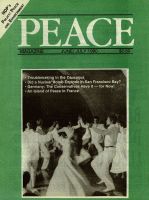
Peace Magazine Jun-Jul 1990, page 24. Some rights reserved.
Search for other articles by David McArthur here
A key impasse in the current Strategic Arms Reduction Talks (START) between the United States and the USSR are strategic bombers and air-launched cruise missiles. America's new B-2 Stealth bomber appears to be the problem.
This bomber has some unusual capabilities. The sinister-looking, bat-like flying wing is invisible to radar and can carry the new generation of stealth air-launched cruise nuclear missiles.
Although there is little public awareness of its cruise missile capability, the latest edition of Jane's "All the World's Alrcraft" confirms it. This capability didn't occur by chance. It has long been planned that the B-2 bomber would replace all other U.S. strategic bombers.
THE U.S. DEFENSE Department has long given bomber development top priority, and was originally determined to spend over $70 billion to build a total of 132 of the bombers. Faced with growing resistance to this figure in Congress and the Senate, Dick Cheney, the Secretary of Defense, has proposed to cut back the spending from $75.4 billion to $61 billion. This would result in the creation of 75 bombers. There is good reason to believe that the Defense Department, in anticipation of the resistance, originally asked for funds far beyond those necessary to make this project possible. Sixteen bombers are already committed or built. The Pentagon has even warned that unless the B-2 fleet is funded it will oppose a new strategic arms pact with the Soviets. This is so since the U.S. hopes to achieve strategic superiority over the USSR via the B-2 bomber in the current START negotiations.
The START negotiations are geared to reducing Superpower nuclear weapons by 50%. The U.S. has stated that ICBMs are destabilizing, and that the slower strategic bombers are preferable since they cannot be used as first strike weapons. But the U.S. has numerical and technical superiority in strategic bombers. It wants START to adopt counting rules that would greatly reduce ICBMs where the USSR has a huge numerical advantage, snd increase the dependence of both sides on strategic bombers.
The primary missior of the B-2 bomber, according to the U.S. Defense Department, is to attack' mobile Soviet ICBMs and command posts, after an initial ICBM exchange. But even U.S. Alr Force officials doubt that this is its primary mission.
Yet the B-2 is capable of a first-strike, by launching stealth cruise missiles in a surprise attack. Although the B-2 bomber is subsonic, its invisibility to radar makes its inability to fly at supersonic speeds irrelevant. The technology and capability of the B-2 leap-frogs all other bombers in the world today, and allows it to strike any nation with impunity.
The USSR lacks the technology to create an anti-B-2 radar detection or defence system. A U.S. Defense Department study has found that the Soviet defenses would be ineffective.
The U.S. also has a new generation of small stealth cruise missiles under production. These missiles share some of the technology which is built into the Stealth bomber, and are also invisible to radar. They can be redirected after launch, are faster than the earlier cruise missiles, and have a longer range. Stealth cruise missiles have been tested in Canada, although in those tests they were carried by B-52 bombers.
Each B-2 bomber could be quickly loaded with 16 stealth cruise missiles, on two internal rotary missile launchers. The stealth feature would allow the entire fleet of B-2 bombers to enter Soviet airspace undetected and launch their missiles. Each bomber could be positioned closest to its targets when it launches its missiles, which in turn would be invisible to radar and could be timed to strike all targets simultaneously. As few as 63 Stealth nombers could strike 1000 targets.
There is an argument which suggests this is the true mission of the Stealth and its stealth cruise missile payload. The B-2 was designed to be invisible to radar. Yet after an initial ICBM exchange, Soviet radar installations would be knocked out, and thus the stealth feature would not be needed. This leaves the first strike option as the true B-2 mission.
The U.S. Defense Department and the White House are currently pressing Congress for B-2 bomber funding even as changes to the climate in Europe and the Soviet bloc undercut the need for strategic nuclear systems. It has even been recently stated that the B-2 can also attack Third World countries which cross the path of the U.S., such as Libya and Panama. This would be an absurd mission for such a high-cost weapons system, yet Dick Cheney is citing this as an important capability, now that the entire reason for strategic weapons systems is vanishing.
Even if the START agreement brings about the long-awaited and welcome destruction of many ICBMs, the B-2 bomber promises to launch a new arms race involving stealth bombers, stealth cruise missiles, and radar detection capabilities.
Awareness of the true strategic significance of the B-2 bomber may help combat funding of a device which is a grotesque expenditure of money and which threatens the START negotiations. U
Mr.McArthur is a freelance journalist.

Peace Magazine Jun-Jul 1990, page 24. Some rights reserved.
Search for other articles by David McArthur here